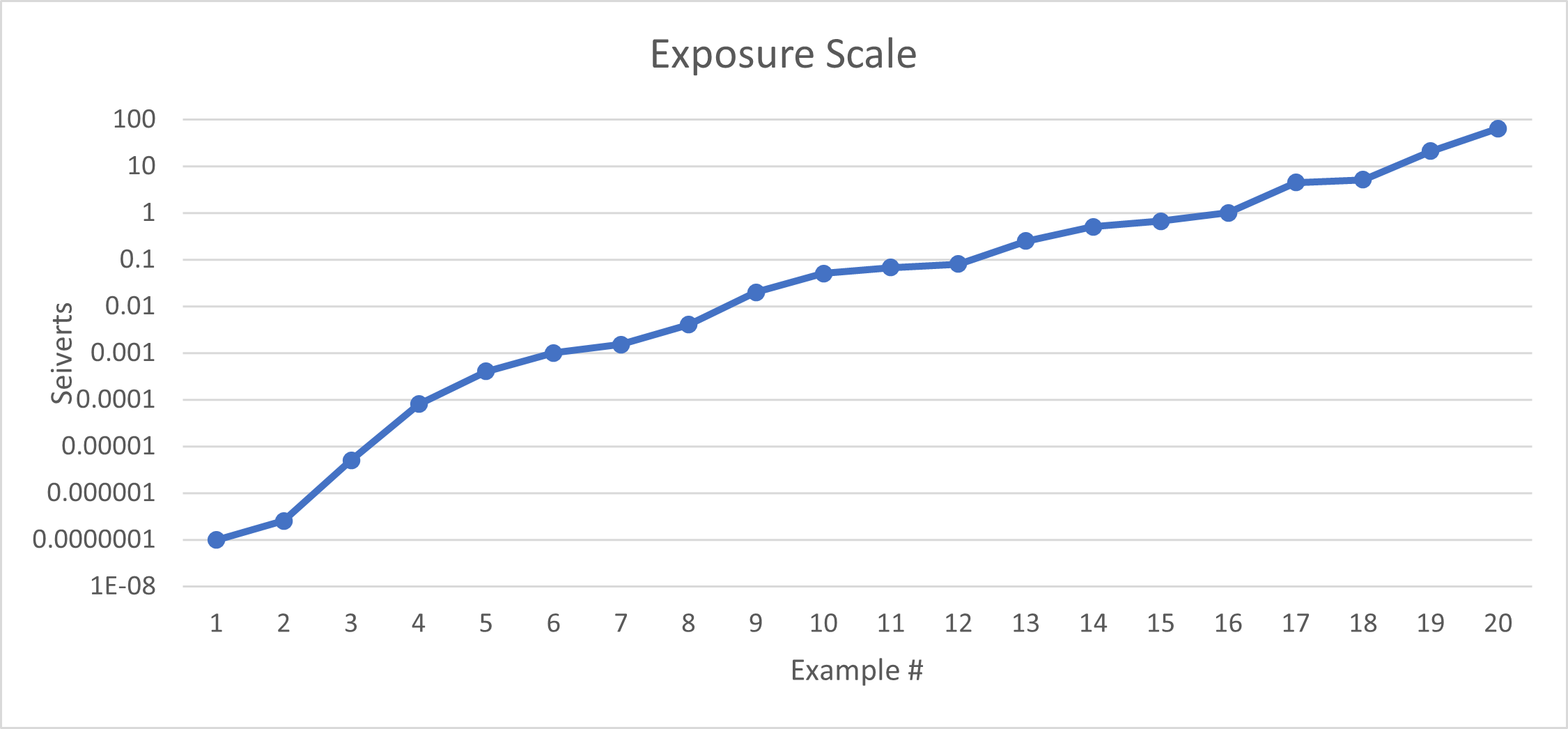My Radiation Monitor
This page is a curated dashboard of data collected by my uRADMonitor, processed by the uRADMonitor data collectors, intermingled with random bits of information grabbed from Wikipedia. By no means am I an expert in any of this. I'm not a physicist, and I don't play one on TV.
Counts per minute is a measure of the detection rate of ionization events per minute. Counts are only manifested in the reading of the measuring instrument, and are not an absolute measure of the strength of the source of radiation. Source
The sievert is a derived unit of ionizing radiation dose in the International System of Units (SI). It is a measure of the health effect of low levels of ionizing radiation on the human body. Source
Fun Comparisons of Things that can Kill You
Okay, fun might not be the right word.
- 0.098 μSv
Banana equivalent dose, a whimsical unit of radiation dose representing the measure of radiation from a typical banana - 0.25 μSv
U.S. limit on effective dose from a single airport security screening - 5 to 10 μSv
One set of dental radiographs - 80 μSv
Average dose to people living within 16 km of Three Mile Island accident - 0.4 to 0.6 mSv
Two-view mammogram, using weighting factors updated in 2007 - 1 mSv
The U.S. 10 CFR § 20.1301(a)(1) dose limit for individual members of the public, total effective dose equivalent, per annum - 1.5 to 1.7 mSv
Annual dose for flight attendants - 2 to 7 mSv
Barium fluoroscopy, e.g. Barium meal, up to 2 minutes, 4–24 spot images - 2 to 7 mSv
Barium fluoroscopy, e.g. Barium meal, up to 2 minutes, 4–24 spot images - 10 to 30 mSv
Single full-body CT scan - 50 mSv
The U.S. 10 C.F.R. § 20.1201(a)(1)(i) occupational dose limit, total effective dose equivalent, per annum - 68 mSv
Estimated maximum dose to evacuees who lived closest to the Fukushima I nuclear accidents - 80 mSv
6 months stay on the International Space Station - 250 mSv
6 month trip to Mars – radiation due to cosmic rays, which are very difficult to shield against - 500 mSv
The U.S. 10 C.F.R. § 20.1201(a)(2)(ii) occupational dose limit, shallow-dose equivalent to skin, per annum - 670 mSv
Highest dose received by a worker responding to the Fukushima emergency - 1 Sv
Maximum allowed radiation exposure for NASA astronauts over their career - 4.5 to 6 Sv
Fatal acute doses during Goiânia accident - 5.1 Sv
Fatal acute dose to Harry Daghlian in 1945 criticality accident - 21 Sv
Fatal acute dose to Louis Slotin in 1946 criticality accident - 64 Sv
Nonfatal dose to Albert Stevens spread over ~21 years, due to a 1945 plutonium injection experiment by doctors working on the secret Manhattan Project.
To get a sense of some of these values we can graph them on a scale. I've taken the lower number of each ranged example.

Linear Scale of Exposure
In this case it's really difficult to get an understanding of what's going on here. Everything sits a smidge above 0 right until you're dead. Lovely. What we really want to see though is the magnitude of the range of values because most things on the graph aren't actually fatal, and more importantly, because it's a little less scary (and maybe a bit more pretty).

Logarithmic Scale of Exposure
Now we can see the full range of values. We're still dead at the same point, but now we can see the relative intensity of each example.
A better example might be found here: https://xkcd.com/radiation/.
The average background radiation dose you get each day sits somewhere between examples 3-4 or 10-20 µSv, assuming no real (serious) sources of radiation are near you. Assuming an average of 15 µSv/day that equates to 5.475 mSv/year. Assuming you live 80 years that means your total dose from background radiation is only about 438 mSv. Maybe. I suck at math.
Device Information
Environmental factors can influence the readings so it's important to compare against what else is going on around the device.
Temperature has strange effects on electronic components. The tube in this device is designed to handle temperature fluctuations fairly well so in theory there won't be any effect on the readings, but severe fluctuations might affect other components such as the microprocessor or the voltage regulator.
However, temperature fluctuations are often the result of changes in weather patterns, which have an effect on readings. A change in temperature and an increased CPM rate might indicate a storm moving nasty airborne particles closer to you.
Geiger-Müller tubes require high voltages to measure ionizing events. Fluctuations in the voltage can reduce accuracy and might indicate device failure.
The tube is powered by a PWM (Pulse Width Modulation) voltage source. This works by turning power on and off really quickly for specified periods of time. The duty cycle (how long it stays on) defines how much useful power can be used by a component. Fluctuations in duty cycle cause fluctuations in voltage and therefore can reduce accuracy and might indicate device failure.
